Whales are some of the oldest animals in the world, with several species living over 100 years. Although whales do have a long lifespan, their lives are often cut short due to human interference. The whaling industry of the 19th and early 20th destroyed global whale populations. According to one reputable source, the commercial whaling wiped out almost three million whales over the last century. Unfortunately, very few species of whales have recovered and several of them are still listed as endangered species. The good news is that whales are now protected internationally and hunting is very limited and typically reserved for native Arctic populations.
10. Common Minke Whale
Average Lifespan: 30 – 50 years
Average Weight: 1.93 – 4.23 tonnes (2.13 – 4.66 short tons)
Location: North Atlantic, North Pacific, and dwarf form in the Southern Hemisphere
Scientific Name: Balaenoptera acutorostrata
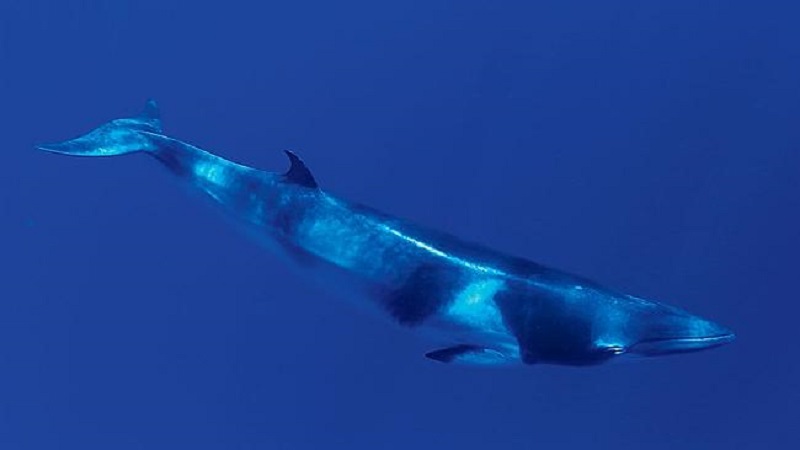
The common minke whale is one of the smallest whale species in the world. The longest common minke whales ever measured were about 9.4–10.05 m (30.8–33.0 ft) in length. Common minke whales primarily live in the North Atlantic and North Pacific, but the dwarf form lives in the Southern Hemisphere.
Although minke whales were ignored by whalers of the past due to its small size, they are now one of the primary targets of the modern whaling industry. As other whale populations have declined, larger numbers of minke whales have been caught in recent years for their meat.
9. Narwhal
Average Lifespan: 40 – 60 years
Average Weight: 800 to 1,600 kg (1,760 to 3,530 lb)
Location: Arctic waters around Greenland, Canada, and Russia
Scientific Name: Monodon monoceros
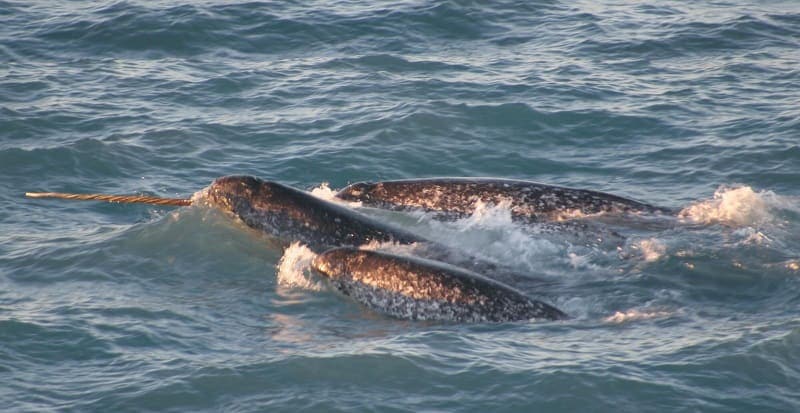
Narwhals are known for being the “unicorns of the sea” because of their distinctive and large tusk, which is actually a canine tooth. The tusk grows out of the left side of the upper jaw and forms a helix spiral that looks like the common depiction of unicorn horns. Although only male narwhals typically grow tusks, about 15 percent of females grow tusks that are smaller with a less noticeable spiral.
Narwhals are medium-sized whales, ranging from 3.95 to 5.5 meters (13 to 18 ft) and weighing about 800 to 1,600 kg (1,760 to 3,530 lb). Unlike other whales, narwhals don’t have a dorsal fin and their neck vertebrae are jointed like other mammals, not fused like most whales and dolphins. In the wild, narwhals can live between 40 – 50 years, but often suffocate to death when the sea ice freezes over.
8. Gray Whale
Average Lifespan: 50 – 70 years
Average Weight: 36 tonnes (40 short tons)
Location: North Pacific and North Atlantic waters
Scientific Name: Eschrichtius robustus
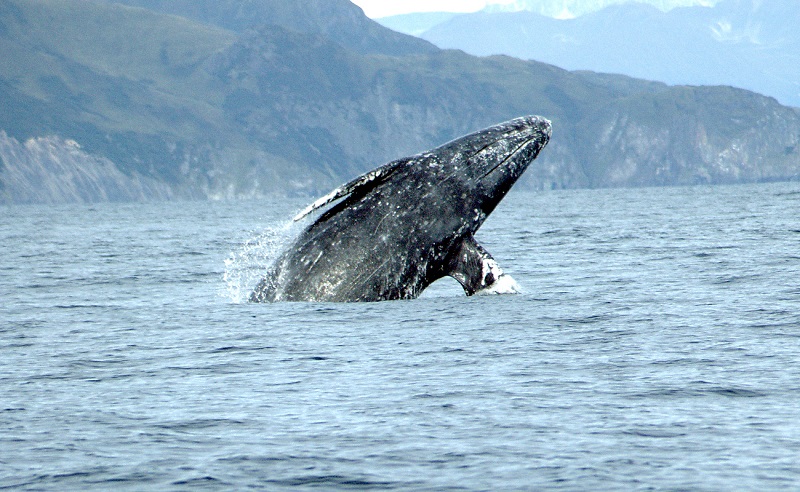
The gray whale is named for the gray patches and white spots that dot its dark skin. Gray whales are the sole species in its genus and family and they are descended from filter-feeding whales that lived over 30 million years ago.
Gray whales are one of the largest whale species, reaching a length of 14.9 meters (49 ft) and a weight of 36 tonnes (40 short tons). Their average lifespan is about 50 – 70 years.
During the height of whaling industry, gray whales were often called devilfish because they fought back when hunted. Although gray whale populations have stabilized and they are considered of least concern, the North Pacific (Asian) population is critically endangered.
7. Sei Whale
Average Lifespan: about 70 years
Average Weight: 28 tonnes (31 short tons)
Location: All oceans, but rarely polar or tropical waters
Scientific Name: Balaenoptera borealis
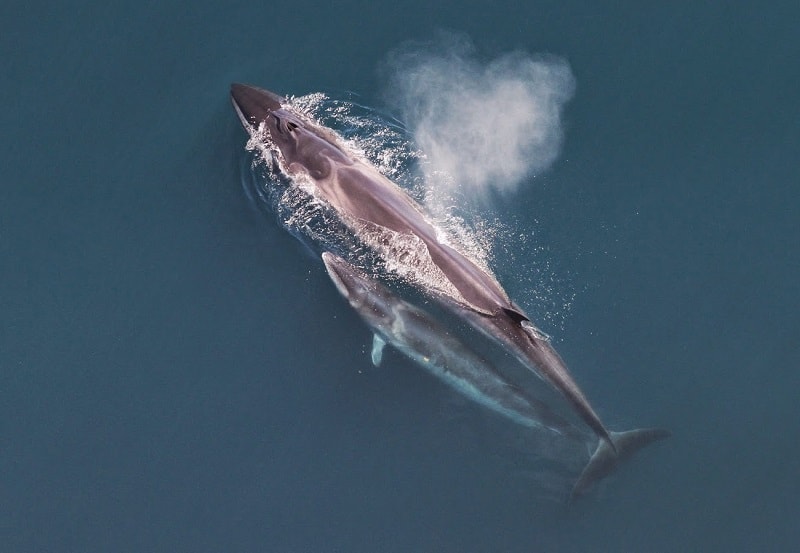
The sei whale is the third largest baleen whale after the blue whale and fin whale. The largest sei whales can grow up to 19.5 m (64 ft) long and weighing as much as 28 tonnes (31 short tons). Although they are massive, sei whales are one of the fastest sea mammals and can reach speeds of 50 km/h (31 mph) (27 knots) over short distances.
Sei whales only live about half as long as blue whales and fin whales, which are the two oldest whale species. One of the most curious things about sei whales is that mass death events have been recorded for many years. In 2015, 337 sei whales washed up in Chile, in what is regarded as the largest mass beaching ever documented. The cause of the mass deaths is unknown, but toxic algae blooms caused by unprecedented warming in the Pacific Ocean may be responsible.
6. Beluga Whale
Average Lifespan: 40 – 80 years
Average Weight: 1,600 kg (3,530 lb)
Location: Arctic and sub-Arctic waters
Scientific Name: Delphinapterus leucas

Along with the narwhal, the beluga whale are the only two members of the Monodontidae whale family. Like the narwhal, belugas are considered medium-sized whales, with the largest specimens growing up to 5.5 m (18 ft) long and weighing up to 1,600 kg (3,530 lb). Belugas have stocky bodies, which is primarily composed of blubber.
Initial research placed beluga’s lifespan at only 30 years, but more recent radiocarbon dating methods suggest that belugas can live up to 70 or 80 years. Belugas are known for their distinctive bright white coloring or whitish-gray coloring. They are one of the most playful whale species and belugas are one of the most commonly kept whales in captivity.
5. Sperm Whale
Average Lifespan: 60 – 80 years
Average Weight: 35 – 59 tonnes (38.5 – 65 short tons)
Location: Worldwide waters and all oceans
Scientific Name: Physeter macrocephalus
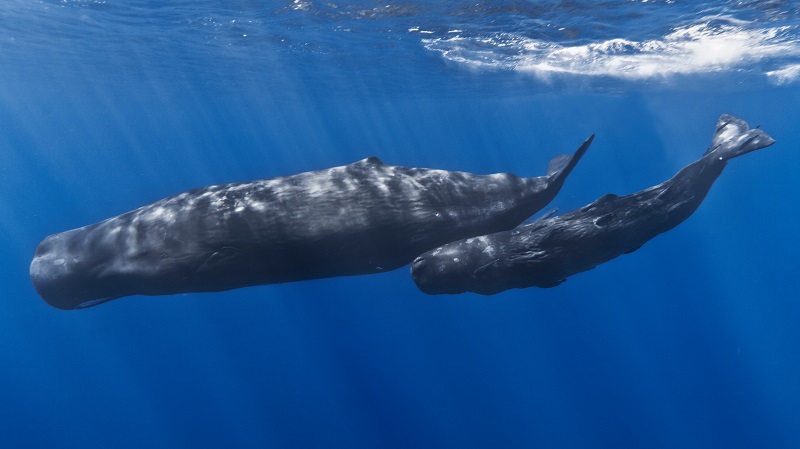
Sperm whales are the largest toothed whales (dolphins, porpoises, and other toothed whales) and the largest toothed predators in the world. They are also the second deepest diving mammal, plunging to depths of 2,250 meters (7,382 ft). Although they are not the largest whale species, sperm whales have the largest brain of any animal on Earth.
Sperm whales don’t live quite as long as other large whale species – their lifespan is about 60 – 80 years. The ambergris (a solid waxy waste product from sperm whale’s digestive system) and spermaceti oil were prime targets of the whaling industry. Sperm whales are now protected by a whaling moratorium, but their ambergris is still highly valuable as a fixative in perfumes and can be collected if its shows up as flotsam from naturally deceased whales.
4. Humpback Whale
Average Lifespan: 45 – 100 years
Average Weight: 36 tonnes (40 short tons)
Location: All major oceans with the four major population groups living in the North Atlantic, Pacific, Southern Ocean, and Indian Ocean
Scientific Name: Megaptera novaeangliae
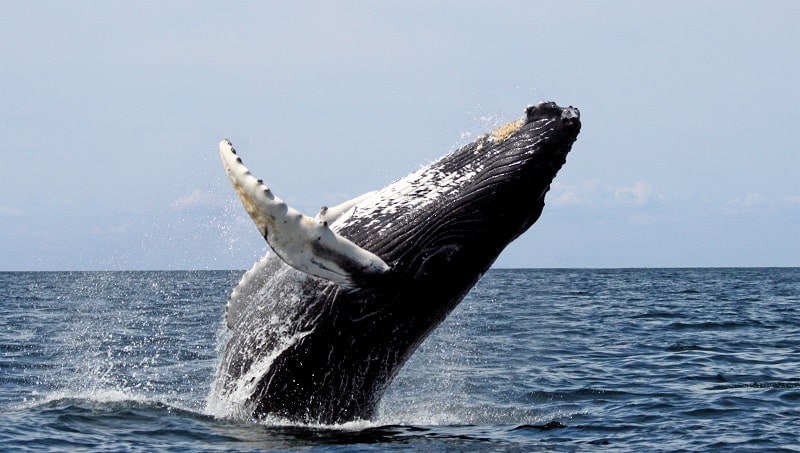
The humpback whale is one of the most recognizable whale species in the world and have become popular due to how often they are seen during whale watching tours. Due to their curious nature, and how approachable they are, humpback whales are a mainstay of ecotourism.
Like other large whales, humpbacks have a fairly long lifepsan, ranging from 45 – 100 years. Humpback whales have many distinctive features that they are known for, including the complex “song” vocalized by male humpbacks. Scientists aren’t sure what the songs are used for and theories suggest that they may be used for mating or challenging other humpback males.
3. Blue Whale
Average Lifespan: 80 – 110 years
Average Weight: 173 tonnes (190 short tons)
Location: North Pacific, Antarctic, and Indian Oceans; waters in the North Atlantic and Southern Hemisphere
Scientific Name: Balaenoptera musculus

The blue whale is known for being the largest known animal to ever exist in the world. Blue whales can grow up to 30 meters (98 ft) in length and have a maximum recorded weight of 173 tonnes (190 short tons), but can weigh more than 181 tonnes (200 short tons). Not much is known about blue whales, but scientists believe that they can live for at least 80 years and some older specimens have been caught.
Although blue whales were hard to kill because of their size, speed, and power, they eventually become one of the most hunted whales in history after steamboats were equipped with harpoon guns. Before their severe depletion, blue whales were abundant in waters around the world. Today, blue whales are listed as an endangered species may only be about 10,000 – 25,000 blue whales left in the world.
2. Fin Whale
Average Lifespan: 94 – 140 years
Average Weight: 74 tonnes (82 short tons)
Location: All of the world’s major oceans and in waters ranging from the polar to the tropical
Scientific Name: Balaenoptera physalus

The fin whale is not only one of the oldest whale species, it is also the second largest mammal on Earth after the blue whale. The largest fin whales can grow to 27.3 m (89.6 ft) long and have a maximum estimated weight of about 114 tonnes (126 short tons). Fin whales have an average lifespan of about 94 years, but some specimens have an estimated age of 135 – 140 years.
Despite their large size, fin whales are slender and one of the fastest whale species. Like other large whales, fin whales were heavily hunted during the 20th century and their numbers have not recovered. They are considered an endangered species, with global population estimates ranging from less than 100,000 to about 119,000.
1. Bowhead Whale
Average Lifespan: 100 – 200 years
Average Weight: 75 to 100 tonnes (83 to 110 short tons)
Location: Arctic and sub-Arctic waters
Scientific Name: Balaena mysticetus

With an average lifespan of about 200 years, the bowhead whale is the oldest existing whale species in the world. They are some of the longest-living mammals in the world and many bowhead whale specimens are estimated to be over 100 years old. Scientists attribute the bowhead whale’s longevity to its resistance to cancer and aging despite having more thousands of more cells than other mammals.
Bowhead whales are the only species of baleen whales who spend their entire lives in the Arctic and sub-Arctic waters. Unlike other whales, bowheads do not migrate to warmer waters to reproduce or feed. In addition to being one of the oldest animals in the world, the bowhead whale has the largest mouth of any animal.











